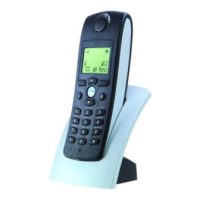AMT/PTD/PBX/0020/2/4/EN 01/2007 Page 107
5.3.4 Switch settings
Automatic resynchronization switch
CA1.2 = ON -> Automatic resynchronization
CA1.2 = OFF -> LDS operation without automatic resynchronization
Remote power supply configuration straps
• J1 set to 1-2 = Remote power supply ON
• J2 set to 1-2 = Remote power supply ON
• J1 set to 2-3 = Remote power supply OFF
• J2 set to 2-3 = Remote power supply OFF
J1: - 48 V or - 40 V
J2: +48 V or +40 V
The two jumpers must be positioned on the same side: 1-2 or 2-3.
DECT configuration switches
• CA1.1 = ON -> Slave mode
• CA1.1 = OFF -> Master mode
5.3.5 LDT card layout
The LDT card can be fitted in the shelves in accordance with the configuration file. The card is
linked to the synchronous bus via the AVADQ plug (
loop DECT clock recovery is not possible with this
plug)
or AVLDT plug (loop DECT clock recovery is possible with FPHBG2 back plane) connected in the
front CFX position (corresponding to the position of CLX on the LDT card).
For more detailed information, refer to document [12] in the reference documents.
The LDT card must be connected to a synchronising clock input in the PBX if a T0 interface is
synchronising on the LDT card.
Each group of 8 S interfaces must be connected to a complete junction (32 TS) on the
synchronous bus of the NeXspan 50. The LDTA card thus requires two junctions.
To synchronize the NeXspan 50, connect the ISDN clock extracted from a T0 access
(synchronising T0 interface) to a 2.048 MHz clock input of the RSU.
Cards CLX0 CLX1 CLX2 CLX3 CLX4 CLX5 CLX6
Junctions
J8 + J12 J9 + J13 J10 + J14 J24 + J28 J25 + J29 J26 + J30 J27 + J31
Capacity
8S (J8)
16S (J8, J12)
8S (J9)
16S (J9, J13)
8S (J10)
16S (J10, J14)
8 S (J24)
16 S (J24, J28)
8 S (J25)
16 S (J25, J29)
8 S (J26)
16 S (J26, J30)
8 S (J27)
16 S (J27, J31)

